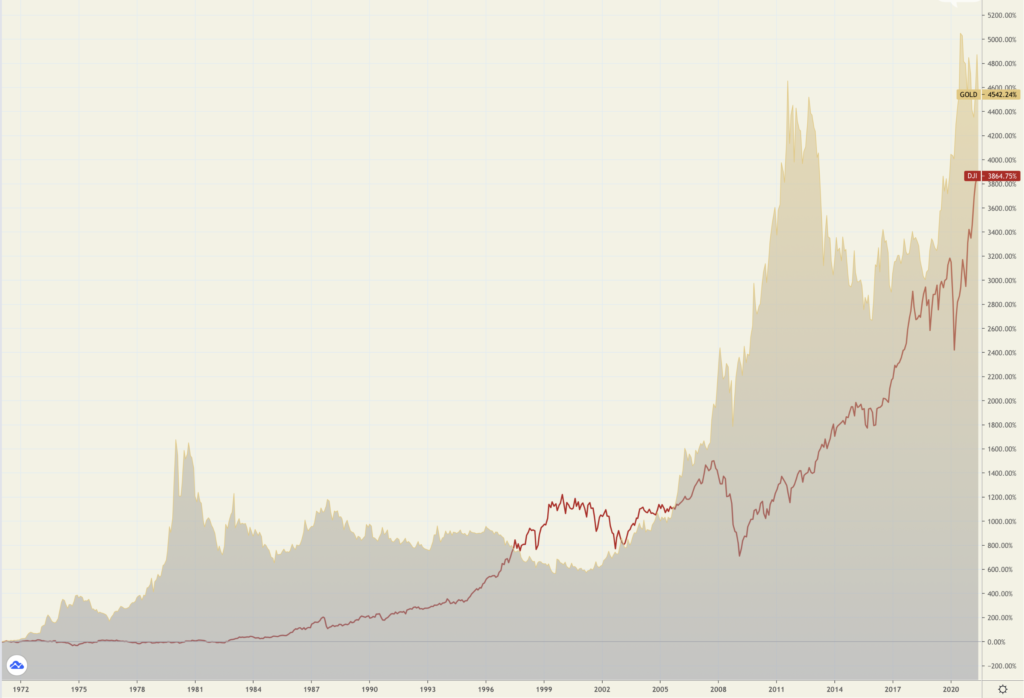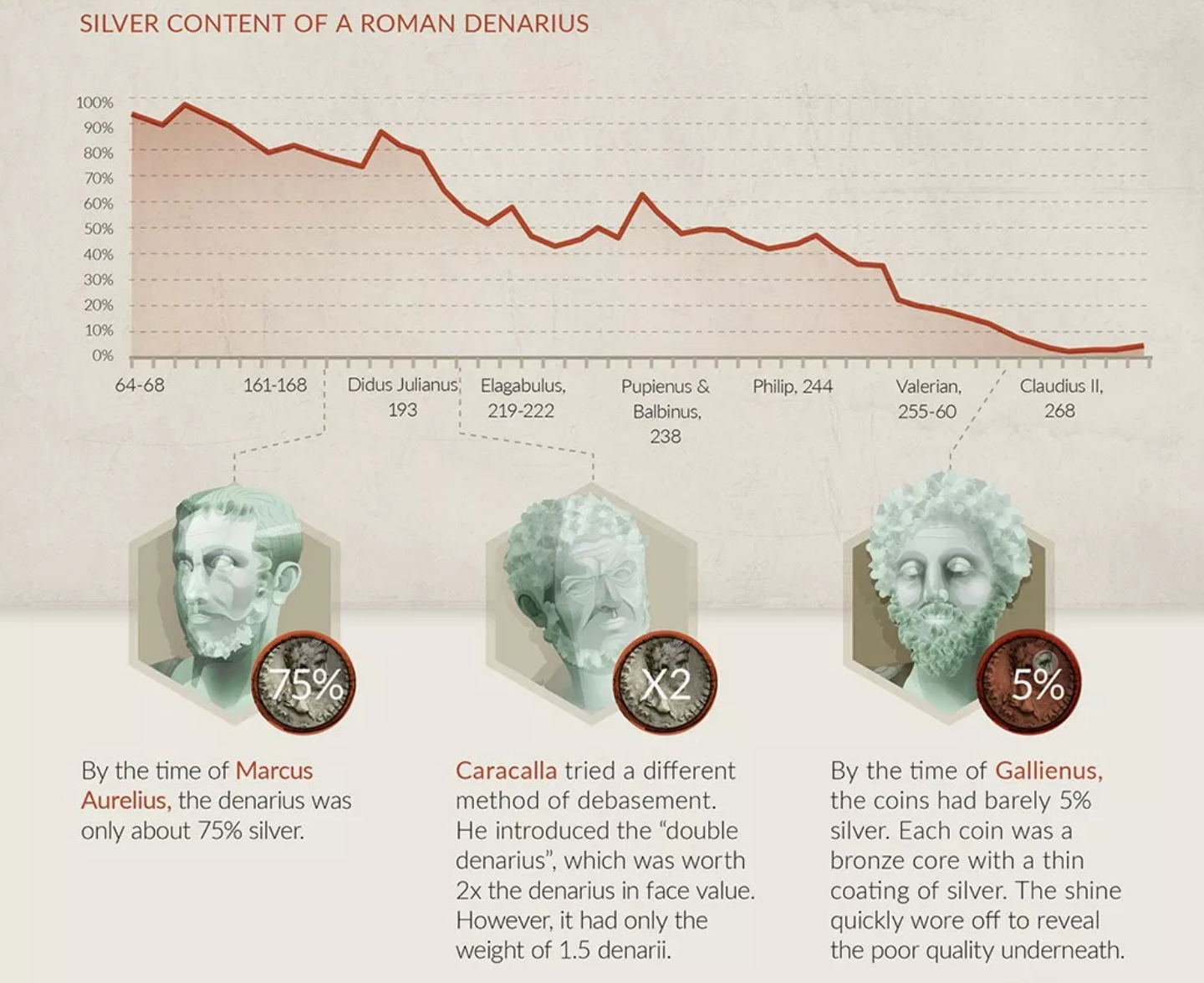NEWS &VIEWS
Forecasts, Commentary & Analysis on the Economy and Precious Metals
Celebrating our 48th year in the gold business
July 2021
“Remember what we’re looking at. Gold is a currency. It is still, by all evidence, a premier currency. No fiat currency, including the dollar, can match it.” – Alan Greenspan, November 2014
–––––––––––––––––––––––––––––––––––––––––––––––––––––––––––––––––––––––––––––––––––––––––––––––––
Gold in the age of inflation
The star investment of the fifty-year era and the most reliable store of value
There has been considerable, and some would say tedious, discussion on the subject of inflation over the past several weeks. The Fed wants it. The markets await it. Investors and consumers worry about it. If it does come, the Fed thinks it will be transitory. Others believe it will persist. That said, the current discussion ignores an established historical reality: We already live and have lived with it for a very long time. The Age of Inflation began in August of 1971 when the United States disengaged the dollar from gold and ushered in the fiat money era. Thereafter, the inflationary process has progressively eaten away at our wealth and the purchasing power of our money. Now, some of the best minds in the investment business tell us that it is about to accelerate and that if we ignore it, we do so at our own peril.
To mark the occasion of the fiat money system’s golden anniversary, we offer two instructive charts. One is something of a myth-buster in that gold has decisively outperformed stocks during the fiat money era. Many will be surprised to learn that gold is up 4,500% since 1971, while stocks have played second fiddle at 3,375%. The other reveals at a glance the pernicious, ongoing debasement of the dollar and gold’s role as a hedge against it. The dollar lost 85% of its purchasing power since 1971, while gold, as just mentioned, gained nearly 4500%. If that does not serve as vindication of gold’s portfolio role in the era of fiat money, I don’t know what will. At the same time, consensus has it that cyclically, stocks are closer to a top than a bottom, and gold is closer to a bottom than a top.
Gold and stocks price performance
(In percent, 1971-2021)

Chart courtesy of TradingView.com • • • Click to enlarge
Gold and the purchasing power of the dollar
(1971 to present)

Sources: St. Louis Federal Reserve [FRED], Bureau of Labor Statistics, ICE Benchmark Administration • • • Click to enlarge
Ross Norman sees the current gold price as the ‘mother of all buying opportunities’ ……
London-based analyst Ross Norman sees gold as situated at the “mother of all buying opportunities” – a circumstance he likens to the early years of the stagflationary 1970s. “The simple truth is our basic democracy is flawed,” he writes in a LinkedIn piece posted Friday. “It encourages government to overpromise, then overspend to win our love and votes, and truth is you don’t deserve the largesse … and we certainly cannot afford it … and it is then paid for by additional money printing or if you prefer, debasement of the currency…If I am right – and I think I am – then owning hard assets is where you need to be. And out of cash. This is rather a long way around for saying that gold looks a pretty good bet and the massive price correction gives, in my view … a great buying opportunity.” Norman goes on to point out that gold achieved a fifteen-fold increase between 1970 and 1980 and, if we had a replay, it would put the price at $26,500. “But of course,” he says, “gold prices had been artificially constrained in the lead-up. So nope, that’s not a forecast … but hopefully you get the picture.”
…… While Michael Burry warns of the ‘mother of all stock market crashes’
Michael Burry of “The Big Short” fame recently tweeted extensively about the German hyperinflation warning of comparisons between the 1923 Weimar Republic disaster and today. “People say I didn’t warn last time,” he said. “I did, but no one listened. So I warn this time. And still, no one listens. But I will have proof I warned.” He then went on a roughly two-month sabbatical. Now, he’s back, and he is apprehensive about a stock market in the grips of a prolonged mania, saying it’s “unnatural, insane and dangerous.” “All hype/speculation is doing is drawing in retail before the mother of all crashes,” he says in a recent Bloomberg interview. “When crypto falls from trillions, or meme stocks fall from tens of billions, MainStreet losses will approach the size of countries. History ain’t changed.”
––––––––––––––––––––––––––––––––––––––––––––––––––––––––––––––––––––––––––––––––––––––––––––––––––
The six keys to successful gold ownership
This eye-opening, in-depth introduction to precious metals ownership will help you avoid many of the pitfalls that befall first-time investors. Find out who invests in gold, what role gold plays in serious investors’ portfolios, and the when, where, why, and how of adding precious metals to your holdings. To end right, it is critical that you start right, and the six keys to successful gold ownership will point you in the right direction.
–––––––––––––––––––––––––––––––––––––––––––––––––––––––––––––––––––––––––––––––––––––––————–
Howe says this Fourth Turning will go to 2030

“To be clear, the road ahead for America will be rough,” writes Neil Howe, author of the modern classic, The Fourth Turning (1997), in a recent analysis posted at Hedgeye. “But I take comfort in the idea that history cycles back and that the past offers us a guide to what we can expect in the future. Like Nature’s four seasons, the cycles of history follow a natural rhythm or pattern. Make no mistake. Winter is coming. How mild or harsh it will be is anyone’s guess, but the basic progression is as natural as counting down the days, weeks, and months until Spring.”
For those who, like me, buy into Howe’s notion of a Fourth Turning, the problem is to get to the other side of the woods with our assets reasonably intact. “Currently, this period began in 2008,” he points out, “with the Global Financial Crisis and the deepening of the War on Terror, and will extend to around 2030. If the past is any prelude to what is to come, as we contend, consider the prior Fourth Turning which was kicked off by the stock market crash of 1929 and climaxed with World War II.” Eventually, he says, we will find our way to a first turning – a time of renewal – but we will be sorely tested before we get there. The precious metals have offered solid protection through the first half of the Fourth Turning. Gold is up 145% since the collapse of Lehman Brothers in September 2008 – the event most analysts associate with the start of the crisis. Silver is up 165%. In both instances, the greatest price acceleration occurred in the early years of the crisis.
Big physical buyers go to the sidelines when paper traders push the price south
The adverse reaction to the Fed’s alleged hawkish turn in the gold market toward the end of June was far more profound than it was in other markets leading to some to ask the question, “Why?” In our view, a good many of the heavyweight professional money managers who endorse gold publicly are physical buyers and quite content to stay out of the way when computer-based trading takes the price down. As buyers of the metal itself and long-term holders for asset preservation purposes, they can enter the market when they think the market has bottomed and add to their stockpiles accordingly.
Too, we are in the middle of the annual summer slowdown in gold trading, so the market is very thin. Though investors, generally speaking, tend to take to the sidelines in the summer months, they are keeping a wary eye this year on unemployment and inflation readings while attempting to gauge, as well, how the Fed might respond. If the market happens to offer a discount, physical buyers globally will not be averse to taking advantage of it.
Gold an ‘obvious candidate’ as a safe asset for the times, says FT’s Armstrong

In a column posted a little over a week ago, Financial Times’ Robert Armstrong reported inquiries from his readership about safe assets in a time of “regime change” in Washington and the “unleashing” of loose fiscal and monetary policies. “Gold is an obvious candidate,” he writes. “It is often touted as an inflation hedge. But that is too general. Gold has one of the most stable relationships to economic fundamentals of any asset. It moves inversely to real interest rates with great regularity, especially in recent years (See chart below) … Gold has followed real rates, slavishly but in reverse, for 15 years, rising when real rates fall and falling when they rise. There is a simple reason: the real return on money is the opportunity cost for holding gold, an asset that yields nothing.”
In that same article, Armstrong makes a point similar to the one we have made consistently in our writings over the past few months. “Gold,” he says,” has one of the most stable relationships to economic fundamentals of any asset. It moves inversely to real interest rates with great regularity, especially in recent years.” If the inflation turns out to be entrenched rather than transitory, gold demand and the price could skyrocket based on its historically proven inverse correlation to real rates.
Armstrong goes a step further by saying gold could rise even if real rates were to go positive because investors would see it as a valuable hedge against general instability. As a long-time reporter at Financial Times and editor of the widely-followed Lex column on the pink pages, Armstrong’s views carry a great deal of credibility in the professional investor community. Armstrong says he is “no gold bug,” but he does offer a fair interpretation of gold’s utility under the current scenario at the link above.
Larry, Larry quite contrary
Wall Street is forever attempting to parse the mindset in Washington, D.C., and more precisely, and perhaps significantly, the mindset of the Biden administration. So when Larry Summers, the former Treasury Secretary and a stalwart in the Democratic Party, went off the reservation describing Biden’s fiscal and monetary policy as being too loose, it turned a lot of heads. Had Biden caved in to the MMT crowd and ultra-left progressives on economic policy?
“Now,” reports Politico under the headline Larry, Larry Quite Contrary, “the Biden administration is more likely to approvingly blast out an email with the latest Paul Krugman column than the latest Summers one (Krugman, notably, did not outright dismiss inflation fears in his column today). While senior Biden officials like Brian Deese and Gene Sperling are colleagues and friends with Summers, the administration is also chock-full of Summers critics – economists who believe that decades of Democratic economic policy that failed to address wage stagnation, outsourcing and rising inequality led to the rise of Donald Trump.”
The Biden administration’s willingness to concede economic policy to that wing of the party amounts to a powerful argument for owning gold and silver. A former staffer with Elizabeth Warren tweeted recently: “I can’t remember the last President who so clearly and unequivocally embraced full employment as their economic goal.” As far as we can gather, the Fed is steadfastly on the same page, despite all the hand-wringing on Wall Street about tapering.

Early this year, John Authers was among the first in journalistic circles to identify the new monetary regime change underway in Washington. “Let’s make a big assumption,” he wrote in an opinion piece posted at Bloomberg. “We really are in the process of not only a great shift toward reflation, but toward a new inflationary regime. What is this like, how can we tell, and what does the future hold?” Now a growing cadre of analysts agrees that the Fed and the federal government have launched a new era in monetary policy.
As the new regime is being deployed, it has become increasingly clear that the Biden policy mix is an attempt to overturn the framework that has been in place since the early 1980s – what the Reagan-Volcker team were to disinflation the Biden-Powell team might be to inflation. Among those early insights from Authers, he offers the following from Alex Lennard of Ruffer LLP. “Volcker said he was going to tame inflation, unemployment be damned. Now it’s the other way around. I don’t think people have quite realized that you’ve had this huge change in the mandate of policymakers.” There is no mystery in all of this with respect to what it means for gold. If we have indeed returned to the 1970s, then gold will play a vital role in the well-balanced portfolio and will be the subject of more than a few financial headlines.
–––––––––––––––––––––––––––––––––––––––––––––––––––––––––––––––––––––––––––––––––––––––————–
“Inflation has no date of beginning. Inflation is the cancer of modern civilization, the leukemia of planning and hope; as with all cancers, no one can say when it begins or how fast it may spread. It is a disease of money, and when money goes, order goes with it. Inflation comes when a government has made too many promises it cannot keep and papers over the shortfall with currency which, ultimately, becomes confetti — and faith is lost.” – Theodore H. White, historian-political journalist, “America in Search of Itself” (1982) As quoted by Authers at the link above.
–––––––––––––––––––––––––––––––––––––––––––––––––––––––––––––––––––––––––––––––––––––––————–
Final Thought

Image courtesy of Visual Capitalist • • • Click to enlarge
We sometimes forget that inflation is a process rather than an event. One of the better-known examples of that axiom is the nearly two centuries-long debasement of Rome’s silver denarius. The Roman citizen who had the wisdom to hedge that process by going to gold at nearly any point along the way ended up preserving some portion, if not all, of his or her wealth. Those who did not suffered its debilitating effects. In the inflationary process, the line between cause and effect is not always a straight one, and its timing difficult to discern. History teaches us, though, that when runaway inflation does arrive, it comes suddenly, without notice, and with a vengeance. That is why it pays to view gold as a permanent and constantly maintained aspect of the investment portfolio. “A change of fortune,” Ben Franklin tells us, “hurts a wise Man no more than a change of the Moon.”
_________________________________________________________________
(Related please see: News & Views Special Report / March 2020 / Hedging the decline and fall of a currency – The baseline case for gold hasn’t changed much in 1700 years)
––––––––––––––––––––––––––––––––––––––––––––––––––––––––––––––––––––––––––––––––––––––––––––––––––
Looking to prepare your portfolio for whatever uncertainty lies ahead
DISCOVER THE USAGOLD DIFFERENCE
ORDER DESK: 1-800-869-5115 x100/orderdesk@usagold.com
ORDER GOLD & SILVER ONLINE 24-7
Up-to-the-minute gold market news, opinion, and analysis as it happens.
If you appreciate NEWS & VIEWS, you might also take
an interest in our Daily Top Gold News and Opinion page.

––––––––––––––––––––––––––––––––––––––––––––––––––––––––––––––––––––
Disclaimer – Opinions expressed on the USAGOLD.com website do not constitute an offer to buy or sell or the solicitation of an offer to buy or sell any precious metals product, nor should they be viewed in any way as investment advice or advice to buy, sell or hold. USAGOLD, Inc. recommends the purchase of physical precious metals for asset preservation purposes, not speculation. Utilization of these opinions for speculative purposes is neither suggested nor advised. Commentary is strictly for educational purposes, and as such, USAGOLD does not warrant or guarantee the accuracy, timeliness, or completeness of the information found here. The views and opinions expressed at USAGOLD are those of the authors and do not necessarily reflect the official policy or position of USAGOLD. Any content provided by our bloggers or authors is solely their opinion and is not intended to malign any religion, ethnic group, club, organization, company, individual, or anyone or anything.
–––––––––––––––––––––––––––––––––––––––––––––––––––––––––––––––––––––––––––––––––––––––––––––
 Michael J. Kosares is the founder of USAGOLD, author of The ABCs of Gold Investing – How To Protect and Build Your Wealth With Gold [Three Editions], and the firm’s publications editor.
Michael J. Kosares is the founder of USAGOLD, author of The ABCs of Gold Investing – How To Protect and Build Your Wealth With Gold [Three Editions], and the firm’s publications editor.


